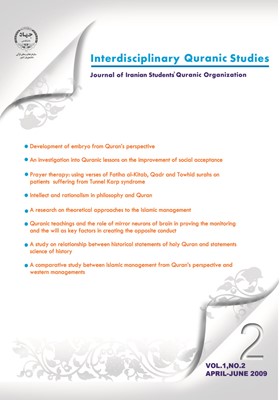Quranic teachings and the role of mirror neurons of brain in proving the monitoring and the will as key factors in creating the opposite conduct
Subject Areas :
1 -
Keywords: Religious doctrines Mirror neuron system Embodied simulation Intention Social behaviors ,
Abstract :
Objective(s): Religious doctrines imply that action observation can be affected by observer behavior and his/her developments, therefore suggests avoiding observation immoral behavior. Religion teaches us that value of behaviors depends on intention of actions. The aim of this article is to study scientific evidences about this doctrine. Methods: A review of literature including Avicenna’s books on mirror neurons. Results: Thinkers such as Avicenna’s have explained this effect very well. Recent studies demonstrated sensory motor neurons called mirror neurons are special neurons that show activity both when the individual is executing a goal directed action and when observing the same action performed by another nonspecific. Mirror neurons present a versatile self-learning mechanism for the coordination of perceptional and motor actions. They also seem to present a potential bridge between minds. An understanding of the coupling of perception with actions via the mirror neurons, and the management of the respective internal representations, has opened the road to elucidating the computational principles underlying human cognition. Evidences suggest that the human mirror neuron system dose not simply provide an action recognition mechanism, but also constitutes a neural system for coding the intention of others. This mirror mechanism may sub serve different functions, including action understanding, empathy, imitation, action prediction, action simulation, and social interaction. Conclusion; In fact mirror neurons can be used to provide rational rather than religious grounds for ethics. Therefore consideration and recognition of the role and function of mirror neuron system and use these findings along with religious instruction improve training models for social skills and social behaviors.

